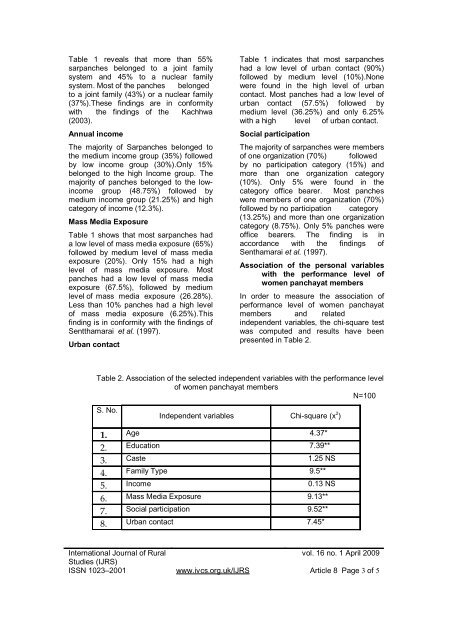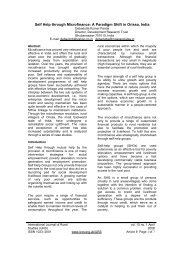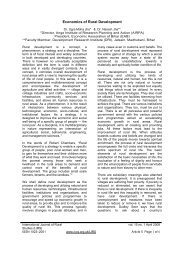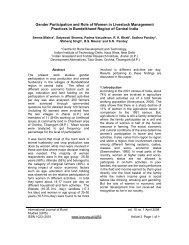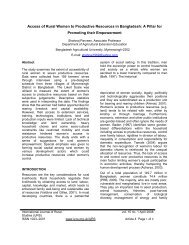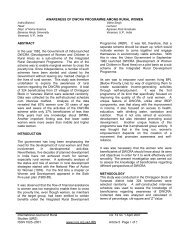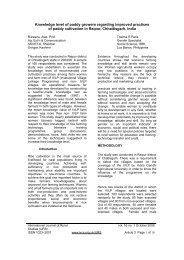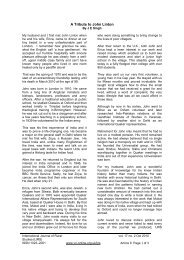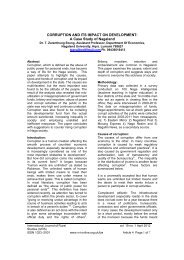women panchayat memb.. - Volunteers for Rural India
women panchayat memb.. - Volunteers for Rural India
women panchayat memb.. - Volunteers for Rural India
Create successful ePaper yourself
Turn your PDF publications into a flip-book with our unique Google optimized e-Paper software.
Table 1 reveals that more than 55%<br />
sarpanches belonged to a joint family<br />
system and 45% to a nuclear family<br />
system. Most of the panches belonged<br />
to a joint family (43%) or a nuclear family<br />
(37%).These findings are in con<strong>for</strong>mity<br />
with the findings of the Kachhwa<br />
(2003).<br />
Annual income<br />
The majority of Sarpanches belonged to<br />
the medium income group (35%) followed<br />
by low income group (30%).Only 15%<br />
belonged to the high Income group. The<br />
majority of panches belonged to the lowincome<br />
group (48.75%) followed by<br />
medium income group (21.25%) and high<br />
category of income (12.3%).<br />
Mass Media Exposure<br />
Table 1 shows that most sarpanches had<br />
a low level of mass media exposure (65%)<br />
followed by medium level of mass media<br />
exposure (20%). Only 15% had a high<br />
level of mass media exposure. Most<br />
panches had a low level of mass media<br />
exposure (67.5%), followed by medium<br />
level of mass media exposure (26.28%).<br />
Less than 10% panches had a high level<br />
of mass media exposure (6.25%).This<br />
finding is in con<strong>for</strong>mity with the findings of<br />
Sentthamarai et al. (1997).<br />
Urban contact<br />
Table 1 indicates that most sarpanches<br />
had a low level of urban contact (90%)<br />
followed by medium level (10%).None<br />
were found in the high level of urban<br />
contact. Most panches had a low level of<br />
urban contact (57.5%) followed by<br />
medium level (36.25%) and only 6.25%<br />
with a high level of urban contact.<br />
Social participation<br />
The majority of sarpanches were <strong>memb</strong>ers<br />
of one organization (70%) followed<br />
by no participation category (15%) and<br />
more than one organization category<br />
(10%). Only 5% were found in the<br />
category office bearer. Most panches<br />
were <strong>memb</strong>ers of one organization (70%)<br />
followed by no participation category<br />
(13.25%) and more than one organization<br />
category (8.75%). Only 5% panches were<br />
office bearers. The finding is in<br />
accordance with the findings of<br />
Senthamarai et al. (1997).<br />
Association of the personal variables<br />
with the per<strong>for</strong>mance level of<br />
<strong>women</strong> <strong>panchayat</strong> <strong>memb</strong>ers<br />
In order to measure the association of<br />
per<strong>for</strong>mance level of <strong>women</strong> <strong>panchayat</strong><br />
<strong>memb</strong>ers and related<br />
independent variables, the chi-square test<br />
was computed and results have been<br />
presented in Table 2.<br />
Table 2. Association of the selected independent variables with the per<strong>for</strong>mance level<br />
of <strong>women</strong> <strong>panchayat</strong> <strong>memb</strong>ers<br />
N=100<br />
S. No.<br />
Independent variables Chi-square (x 2 )<br />
1. Age 4.37*<br />
2. Education 7.39**<br />
3. Caste 1.25 NS<br />
4. Family Type 9.5**<br />
5. Income 0.13 NS<br />
6. Mass Media Exposure 9.13**<br />
7. Social participation 9.52**<br />
8. Urban contact 7.45*<br />
International Journal of <strong>Rural</strong><br />
vol. 16 no. 1 April 2009<br />
Studies (IJRS)<br />
ISSN 1023–2001 www.ivcs.org.uk/IJRS Article 8 Page 3 of 5


